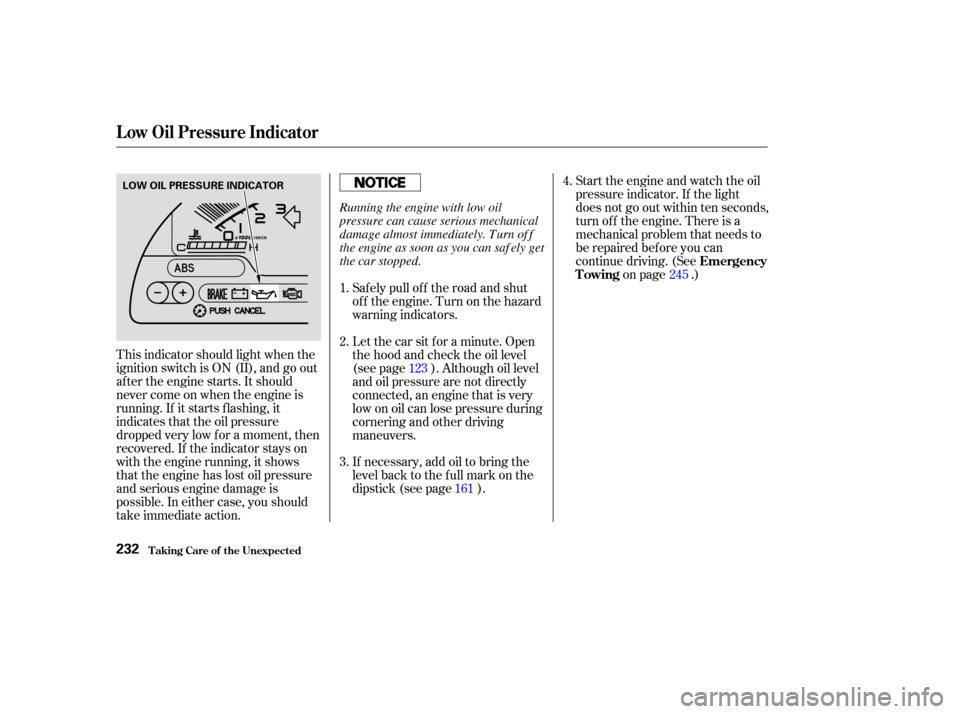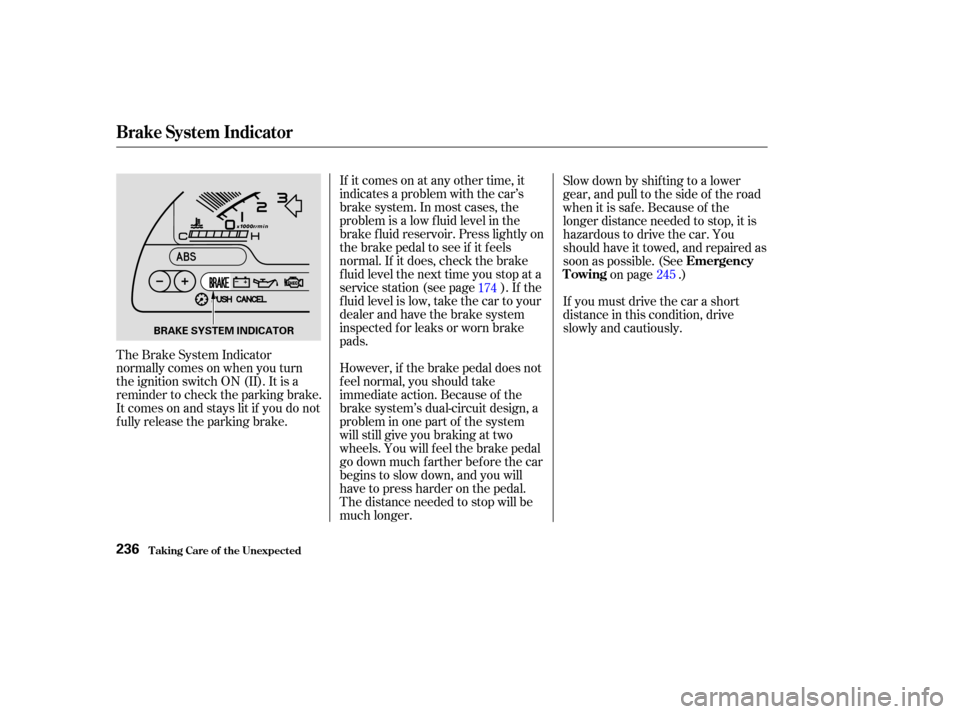tow HONDA S2000 2003 1.G User Guide
[x] Cancel search | Manufacturer: HONDA, Model Year: 2003, Model line: S2000, Model: HONDA S2000 2003 1.GPages: 280, PDF Size: 3.9 MB
Page 209 of 280

Block the rear wheels.
Disconnect the battery.If possible, run the engine f or a
while periodically (pref erably once
amonth).
Support the f ront wiper blade
arms with a f olded towel or rag so
they do not touch the windshield.
To minimize sticking, apply a
silicone spray lubricant to all door
and trunk seals. Also, apply a
vehiclebodywaxtothepainted
surfaces that mate with the door
and trunk seals.
Fill the f uel tank.
Change the engine oil and f ilter
(see page ).
Wash and dry the exterior
completely.
Cleantheinterior.Makesurethe
carpeting, floor mats, etc. are
completely dry.
If you need to park your car f or an
extended period (more than one
month), there are several things you
should do to prepare it f or storage.
Proper preparation helps prevent
deterioration and makes it easier to
get your car back on the road. If
possible, store your car indoors.
If the car is to be stored for a
longer period, it should be
supported on jackstands so the
tires are of f the ground.
Leave one window open slightly (if
the car is being stored indoors).Coverthecarwitha‘‘breathable’’
cover, one made f rom a porous
material such as cotton.
Nonporous materials, such as
plastic sheeting, trap moisture,
which can damage the paint.
If you store your car f or 12 months
or longer, have your Honda dealer
perf orm the inspections called f or in
the 24 months/30,000 miles (48,000
km) maintenance schedule as soon
as you take it out of storage (see
page ). The replacements called
f or in the maintenance schedule are
not needed unless the car has
actually reached that time or mileage.
Raise the convertible top cover.
Leave the parking brake off. Put
the transmission in Reverse. 163
152
Maint enance
St oring Your Car
206
Page 211 of 280

Fill a bucket with cool water. Mix
in a mild detergent, such as
dishwashing liquid or a product
made especially f or car washing. Rinse the car thoroughly with cool
water to remove loose dirt.
Frequent washing helps preserve
your car’s beauty. Dirt and grit can
scratch the paint, while tree sap and
bird droppings can permanently ruin
the f inish.
Wash your car in a shady area, not in
direct sunlight. If the car is parked in
the sun, move it into the shade and
let the exterior cool down bef ore you
start.
Only use the solvents and cleaners
recommendedinthisOwner’s
Manual.
Check the body f or road tar, tree
sap, etc. Remove these stains with
tar remover or turpentine. Rinse it
of f immediately so it does not
harm the f inish. Remember to re-
wax these areas, even if the rest ofthe car does not need waxing.
Do not use harsh chemicals to
remove stains from the
convertible top or rear window.
Use a mild detergent/water
solution with a soft-bristle brush
on the top, and with a sof t cloth on
the rear window.
When you have washed and rinsed
the whole exterior, dry it with a
chamois or sof t towel. Letting it
air-dry will cause dulling and water
spots.
Make sure the top is completely
drybeforeyoufoldit.
As you dry the car, inspect it f or
chips and scratches that could allow
corrosion to start. Repair them with
touch-up paint (see page ).
Wash the car, using the water and
neutral detergent solution and
sponge or sof t cloth. Start at a top
and work your way down. Rinse
f requently.
210
Exterior Care
Appearance Care
Washing
208
Chemical solvents and strong cleaners
can damage the paint, metal, and
plastic on your car.
Page 216 of 280

Clean the windows, inside and out,
with a commercially-available glass
cleaner. You can also use a mixture
of one part white vinegar to ten parts
water. This will remove the haze that
builds up on the inside of the
windows. Use a sof t cloth or paper
towels to clean all glass and clear
plastic surf aces.If you use a liquid air f reshener,
make sure you f asten it securely so it
does not spill as you drive. Two f actors normally contribute to
causing corrosion in your car:
Moisture trapped in body cavities.
Dirtandroadsaltthatcollectsin
hollows on the underside of the
car stays damp, promoting
corrosion in that area.
Removal of paint and protective
coatings f rom the exterior and
underside of the car.
If you want to use an air f reshener/
deodorizer in the interior of your car,
it is best to use a solid type. Some
liquid air f resheners contain chemi-
cals that may cause parts of the
interior trim and f abric to crack or
discolor.
If you get any glass cleaner on the
convertible top, immediately spray
the area with water, and dry it with a
sof t cloth. 1.
2.
Windows
A ir Fresheners Corrosion Protection
Int erior Care, Corrosion Prot ect ion
Appearance Care213
The rear window def ogger is bonded to
the inside of the glass. Wiping
vigorously up-and-down can dislodge
and break these wires. When cleaning
therearwindow,usegentlepressure
and wipe side-to-side.
Page 220 of 280

This section covers the more-
common problems that motorists
experience with their vehicles. It
gives you inf ormation about how to
safely evaluate the problem and what
to do to correct it. If the problem has
stranded you on the side of the road,
you may be able to get going again.
If not, you will also f ind instructions
on getting your car towed.......................
Compact Spare Tire .218
....................
Changing a Flat Tire .219
..........
If Your Engine Won’t Start . 224
Nothing Happens or the Starter Motor Operates ........................
Very Slowly .224
The Starter Operates ................................
Normally .225
................................
Jump Starting .226
............
If Your Engine Overheats . 229
.........
Low Oil Pressure Indicator . 232
..........
Charging System Indicator . 233
.......
Malf unction Indicator Lamp . 234
...............
Brake System Indicator . 236
.......
Closing the Convertible Top . 237
..............................................
Fuses .238
..........
Checking and Replacing . 239
.................
If Your Car Gets Stuck . 243
......................
Emergency Towing .245
Taking Care of the Unexpected
T aking Care of t he Unexpect ed217
Page 227 of 280

You hear nothing, or almost
nothing. The engine’s starter
motor does not operate at all, or
operates very slowly.
You can hear the starter motor
operating normally, or the starter
motor sounds like it is spinning
f aster than normal, but the engine
does not start up and run.Your car has the Immobilizer
System. You should use a
properly-coded master or valet key
to start the engine (see page ).
A key that is not properly coded
will cause the immobilizer system
indicator in the dash panel to blink
rapidly.
Check these things:
Diagnosing why your engine won’t
start f alls into two areas, depending
on what you hear when you press
the ENGINE START button.
When you press the ENGINE
START button, you do not hear the
normal noise of the engine trying to
start. You may hear a clicking sound
or series of clicks, or nothing at all. Turn the ignition switch to ON (II).
Turn on the headlights and check
their brightness. If the headlights
are very dim or don’t light at all,
the battery is discharged. See
on page .
Press the ENGINE START button,
then release it. If the headlights do
not dim, check the condition of the
f uses. If the f uses are OK, there is
probably something wrong with
the electrical circuit f or the
ignition switch or starter motor.
You will need a qualif ied
technician to determine the
problem. (See on page .)
59 226
245
Nothing Happens or the Starter
Motor Operates Very Slowly
Jump Starting
Emergency
Towing
If Your Engine Won’t Start
T aking Care of t he Unexpect ed224
Page 228 of 280

There may be an electrical
problem, such as no power to the
f uel pump. Check all the f uses
(see page ).
If youfindnothingwrong,youwill
need a qualif ied technician to f ind
the problem. See on page .
Do you have f uel? Turn the
ignition switch to ON (II) for a
minute and watch the f uel gauge.
The low f uel level warning light
may not be working, so you were
not reminded to f ill the tank. Are you using the proper starting
procedure? Ref er to on page .
If the headlights dim noticeably or
go out when you try to start the
engine, either the battery is dis-
charged or the connections are
corroded. Check the condition of the
battery and terminal connections
(see page ). You can then try
jump starting the car from a booster
battery (see page ).
In this case, the starter motor’s
speed sounds normal, or even f aster
than normal, when you press the
ENGINE START button, but the
engine does not run.
181
226 135239
245
T he Starter Operates Normally
Emergency
Towing
Starting the
Engine
If Your Engine Won’t Start
T aking Care of t he Unexpect ed225
Page 233 of 280

Look f or any obvious coolant leaks,
such as a split radiator hose.
Everything is still extremely hot,
so use caution. If you f ind a leak, it
must be repaired bef ore you
continue driving (seeon page ). If you don’t f ind an obvious leak,
check the coolant level in the
radiator reserve tank (see page
). If the level is below the
MIN mark, add coolant to halfway
between the MIN and MAX marks. Using gloves or a large heavy
cloth, turn the radiator cap
counterclockwise, without pushing
down, to the f irst stop. This
releases any remaining pressure in
the cooling system. After the
pressure releases, push down on
the cap and turn it until it comes
of f .
If there was no coolant in the
reserve tank, you may also have to
add coolant to the radiator. Let the
engine cool down until the reading
reaches the middle of the
temperature gauge, or lower,
bef ore checking the radiator.
6.
7.9.
8.
245 124
Emergency
Towing
If Your Engine Overheats
T aking Care of t he Unexpect ed230
Removing the radiator cap
while the engine is hot can
cause the coolant to spray out,
seriously scalding you.
Always let the engine and
radiator cool down before
removing the radiator cap.
Page 234 of 280

Start the engine and set the
temperature control dial to
maximum. Add coolant to the
radiator up to the base of the f iller
neck. If you do not have the
proper coolant mixture available,
you can add plain water.
Remember to have the cooling
system drained and ref illed with
the proper mixture as soon as you
can.Put the radiator cap back on
tightly. Run the engine and watch
the temperature gauge. If it goes
back to the red mark, the engine
needs repair. (See
on page .) If the temperature stays normal,
check the coolant level in the
radiator reserve tank. If it has
gone down, add coolant to the
MAX mark. Put the cap back on
tightly.
10.
12.
11.
245Emergency
Towing
If Your Engine Overheats
T aking Care of t he Unexpect ed231
Page 235 of 280

This indicator should light when the
ignition switch is ON (II), and go out
af ter the engine starts. It should
never come on when the engine is
running. If it starts f lashing, it
indicates that the oil pressure
dropped very low f or a moment, then
recovered. If the indicator stays on
with the engine running, it shows
that the engine has lost oil pressure
and serious engine damage is
possible. In either case, you should
take immediate action.Start the engine and watch the oil
pressure indicator. If the light
does not go out within ten seconds,
turn of f the engine. There is a
mechanical problem that needs to
be repaired bef ore you can
continue driving. (See
on page .)
Saf ely pull of f the road and shut
of f the engine. Turn on the hazard
warning indicators.
If necessary, add oil to bring the
level back to the full mark on the
dipstick (see page ). Letthecarsitforaminute.Open
the hood and check the oil level
(see page ). Although oil level
and oil pressure are not directly
connected, an engine that is very
low on oil can lose pressure during
cornering and other driving
maneuvers.
1.
2.
3. 4.
123 161 245
Emergency
Towing
L ow Oil Pressure Indicator
T aking Care of t he Unexpect ed232
LOW OIL PRESSURE INDICATOR
Running the engine with low oil
pressure can cause serious mechanical
damage almost immediately. Turn of f
the engine as soon as you can saf ely get
the car stopped.
Page 239 of 280

If it comes on at any other time, it
indicates a problem with the car’s
brake system. In most cases, the
problem is a low f luid level in the
brake f luid reservoir. Press lightly on
the brake pedal to see if it f eels
normal. If it does, check the brake
f luid level the next time you stop at a
service station (see page ). If the
fluid level is low, take the car to your
dealer and have the brake system
inspected f or leaks or worn brake
pads.
However, if the brake pedal does not
f eel normal, you should take
immediate action. Because of the
brake system’s dual-circuit design, a
problem in one part of the system
will still give you braking at two
wheels. You will f eel the brake pedal
go down much f arther bef ore the car
begins to slow down, and you will
have to press harder on the pedal.
The distance needed to stop will be
much longer.
The Brake System Indicator
normallycomesonwhenyouturn
the ignition switch ON (II). It is a
reminder to check the parking brake.
It comes on and stays lit if you do not
f ully release the parking brake. Slow down by shif ting to a lower
gear, and pull to the side of the road
when it is saf e. Because of the
longer distance needed to stop, it is
hazardous to drive the car. You
should have it towed, and repaired as
soon as possible. (See
on page .)
If you must drive the car a short
distance in this condition, drive
slowly and cautiously.
174
245
Brake System Indicator
T aking Care of t he Unexpect ed
Emergency
Towing
236
BRAKE SYSTEM INDICATOR